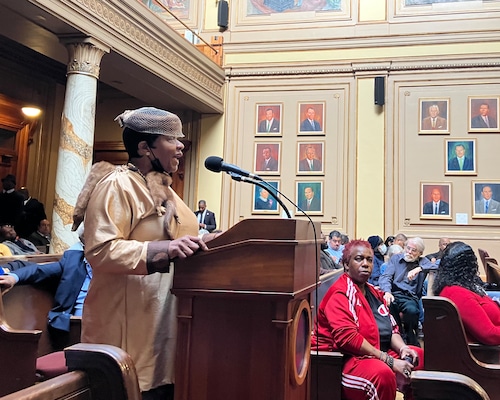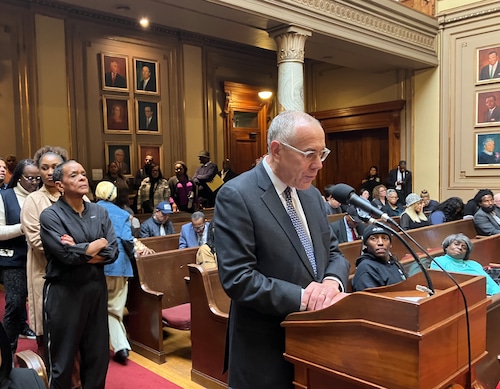In a split vote, the Newark City Council on Wednesday adopted a set of controversial zoning changes that, among other things, encourage the development of high-density housing and more small businesses along major corridors.
The measures, proposed by the administration of Mayor Ras J. Baraka, are intended to revitalize neighborhoods, ease restrictions on home businesses, tighten controls on warehouse development, and increase the supply of market-rate and affordable housing.
“It’s a good day for Newark,” said Allision Ladd, Baraka’s deputy mayor for economic and housing development.
After granting preliminary approval for the changes on Oct.4, the council voted 5-3 with one abstention to adopt them on Wednesday, reflecting the divided view of the changes among residents, developers and other community members.
Council President Lamonica McIver and Council members Patrick Council, C. Lawrence Crump, Dupré Kelly and Louise Scott-Rountree voted in favor; Louis Quintana, Anibal Ramos and Carlos Gonzalez voted against; and Michael Silva abstained.
The changes, which take effect 21 days after the vote, include permitting a wider variety of uses in existing commercial corridors.
Apartment buildings with ground-floor commercial space will be allowed on thoroughfares previously limited to multi-family houses. The maximum height of apartment buildings will increase. And for areas zoned for single-, two-, and three-family family homes, setbacks from other structures will be reduced. Three-family homes will be permitted where only two- or single-family homes had been, areas known as R2 zones.
Small houses or apartments, known as “ancillary dwelling units,” or ADUs, will be allowed on the same lot as existing single-family homes to provide affordable, adjacent living space for elderly or young adult family members.
The new zoning changes would help create affordable housing indirectly by encouraging large-scale residential projects that will be subject to the city’s existing requirement that developers set aside 20% of apartments in new buildings of 15 units or more for people with low and moderate incomes.
Ladd said the city had not projected how many market rate or affordable housing units they could produce.
But critics of the set-aside requirement, known as “inclusionary zoning,” say even the units labeled affordable are still priced out of reach of many Newarkers.
“There’s no question that new development contributes to the city’s wealth,” John Goldstein, a city resident and member of the nonprofit group Homes for All Newark, told the council. “The question is, who is the new development benefitting?”
Others argued that the changes would alter the character of neighborhoods, with increases in residential density and the arrival of businesses and create parking shortages and other problems. City officials and other proponents say the changes will revitalize neighborhoods, provide needed shops, restaurants and services, making neighborhoods more walkable and creating jobs.
Some opponents suggested out-of-town developers would be the main beneficiaries of the changes. But supporters at Wednesday’s meeting included local developers of small and medium-sized projects, including Alberto Goncalves, a partner with Newark native Queen Latifah on a 60-unit project that has 16 affordable apartments, and Siree Morris, who developed and operates the Newark Moonlight Cinema with his wife, Ayana.
The changes have been in the works since 2021. They were drafted by planning consultants Heyer, Guel & Associates. Opponents include noted industry professional, urban designer and former Newark planning director Damon Rich, a resident.
Ladd said the city held community engagement meetings in each of its five wards to include residents in the process and learn what they wanted, though opponents said the changes were too numerous and complex to adopt on Wednesday.
“We need more time,” West Ward resident Pamela Daniels pleaded with the council.
But supporters said the time had come for Newark and its 311,000 residents to embrace its position as New Jersey’s largest city, with zoning changes that would harness its growth for the sake of present and future generations.
“We are the largest city in New Jersey,” said Council before voting to adopt the changes. “And at a certain point, we have to act like the largest city.”

On Wednesday, Evelyn Williams, a resident of Newark's South Ward, told the Newark City Council she would have liked more transparency in drafting zoning changes it approved later that night. Steve Strunsky | NJ Advance Media For NJ.com

Stories by Steve Strunsky
Nobody knows Jersey better than NJ.com Sign up to get breaking news alerts straight to your inbox.
Steve Strunsky may be reached at sstrunsky@njadvancemedia.com

